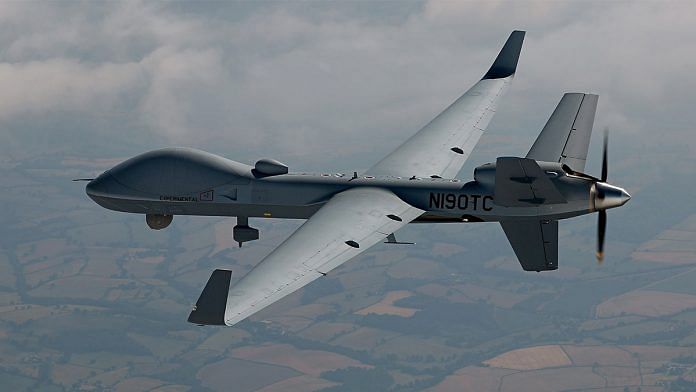New Delhi: Impressed with the performance of the two leased Sea Guardian drones, the Navy, Army and the Air Force will finally jointly procure 30 armed versions of the American unmanned aerial system in what could be a $3 billion deal, ThePrint has learnt.
The decision comes just before US Secretary of Defense Lloyd Austin’s visit to India later this month. Austin’s visit could be a precursor to the impending meet of the ‘Quad’ leaders — US, India, Australia and Japan — which is likely to be held soon.
According to sources in the defence and security establishment, initially one of the three services were not on board about procuring the armed predator drones but now all three are finally on the same page.
They added that the Defence Minister Rajnath Singh-led Defence Acquisition Council (DAC) could take a final decision on this “soon”.
If approved, this would be the first tri-service procurement since Chief of Defence Staff General Bipin Rawat was appointed to steer the Indian armed forces into a more united force, both in terms of operational doctrine and procurement.
The erstwhile Trump administration had expected the deal for 30 armed drones to be announced at the two-plus-two ministerial dialogue in New Delhi on 27 October 2020. However, India did not succumb to the hard American push to seal the deal then.
Also read: Break down civil-military silos, indigenise customs & doctrines, Modi tells armed forces
India to procure armed version of Sea Guardian drones
In 2018, the US had offered India the armed version of the Guardian drones, which were originally authorised for sale as unarmed and for surveillance purposed.
India was earlier eyeing both the unarmed Sea Guardian drones for the Navy and the armed Predator B for attack options, but there was a growing feeling that both surveillance and attack could be done by the same drone.
This was because of the prohibitive price involving American drones. The Navy had initially planned for 22 Sea Guardians which were priced at over $2 billion, but then brought down the number to just 12.
However, since all the three services wanted weaponised drones, a decision was taken to jointly pursue the deal.
According to the deal, India will be acquiring 30 MQ-9 Reaper or Predator B, 10 each for the three services.
The MQ-9B has an endurance of 48 hours and a range of over 6,000 nautical miles. It comes with nine hard-points, capable of carrying sensors and laser-guided bombs besides air-to-ground missiles, with a maximum payload of two tonnes.
The Navy, which is the lead agency for procurement of HALE (High Altitude Long Endurance) UAVs, will seek the Acceptance of Necessity (AON) from the DAC.
In November last year, ThePrint had reported that the Navy had inducted two Sea Guardian drones on lease under emergency procurement.
According to sources, the Navy is really impressed with the two UAVs it took on lease from the US firm General Atomics.
Also read: India’s resolute response on borders has helped in resolution of key issues — Rajnath Singh
Other contracts
This development comes as India pursues ‘Project Cheetah’, under which a Rs 5,500 crore contract is being taken up to upgrade the ‘Heron’ medium-altitude long-endurance drone fleet with all three services into an armed one.
The Navy is also pursuing another contract for 10 Naval Shipborne Unmanned Aerial System, for which American firm Boeing is the front runner.
It is also looking at leasing minesweeper vessels and helicopters, as reported in December last year.
In an earlier interview to ThePrint, Rémi Maillard, president of Airbus India and the company’s managing director for South Asia, had said that they are in talks with the Navy to lease out Panther helicopters for its warships, as the force looks at bridging the capability gap it faces when it comes to the rotary wing.
Also read: 2 accidents in 2 weeks kill 2 Army and BSF men, Ordnance Board ammo in spotlight again




सेना के लिए
Instead of focusing on multiple problems such as poverty, corruption, instability, inequality and violation of minority rights, barbarism over Muslims etc. India is bent upon increasing its defence budget. It exposes Indian hegemonic designs for the South Asian region. It is ultimately becoming the primary reason for instability and insecurity not only for Pakistan but also for other regional states. Furthermore, both India and Pakistan are considered arch-rivals in the South Asia region.
It’s General Dynamics not General Atomics. General Atomics is an energy company.
While drones are great and the final arrival is still a while away , just like in celluloid, control of drones can be taken away from anyone if adversaries have the sufficient technical know-how and advance knowledge which seems to be case with our eastern neighbors.
@Abhay R: What makes you think that you are smarter than the Indian/American govts. & the drone vendors??!!
In the early 90s the talk of improving telephone connectivity meant miles of telephone lines and multistory buildings housing telephone exchanges. but with the advent of the mobile the situation changed in an unimaginable way.
Similarly the concept of weaponization also seems to be moving away from the sophisticated ships and aircrafts manned by highly trained pilots, to missiles and armed UAVs both for attacks and defence.
That seems to be reason for Navy, Army and IAF finally agreeing to procure armed drones.The development, acquisition, production, upgradation and maintenance of the conventional Navy, Army and Force assets is humongous task, if that load can reduced why not.
In missile technology our capabilities are well known with the near perfect and cost effective performance of ISRO. Adoption for defense capabilities does not need reinventing the wheel.
@Vijay Galande: Correct!! Yet!! India should aim for making it’s own drowns & software in the next 5-10 years!!